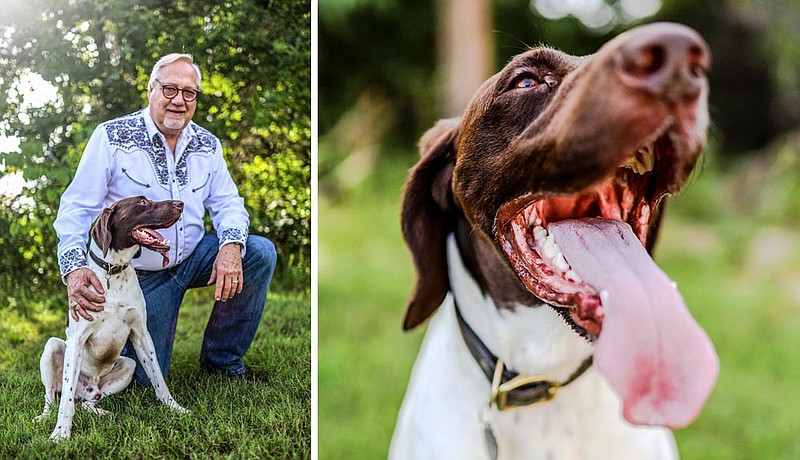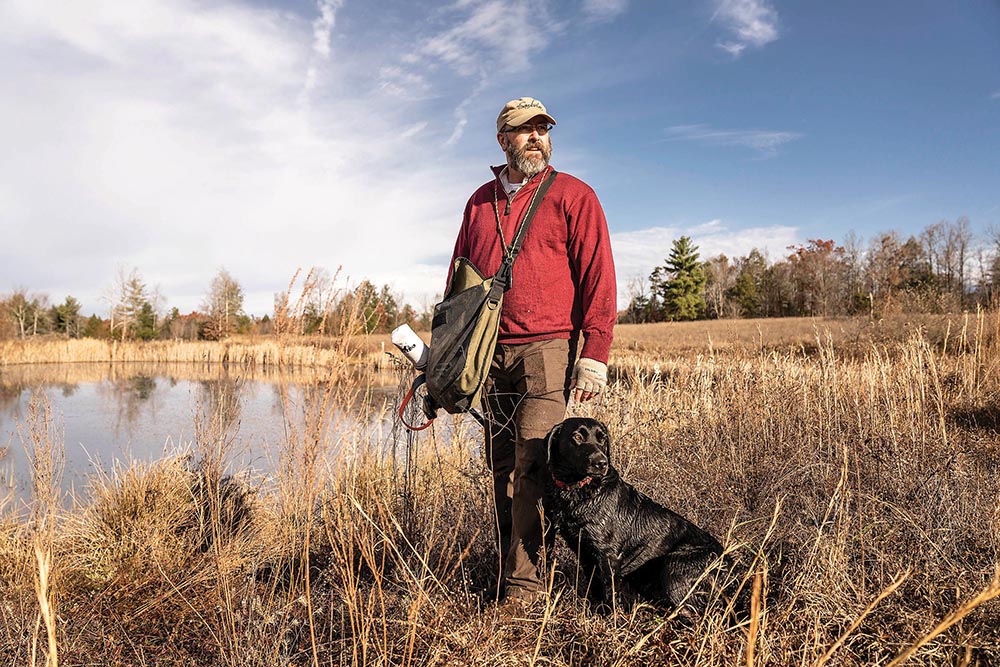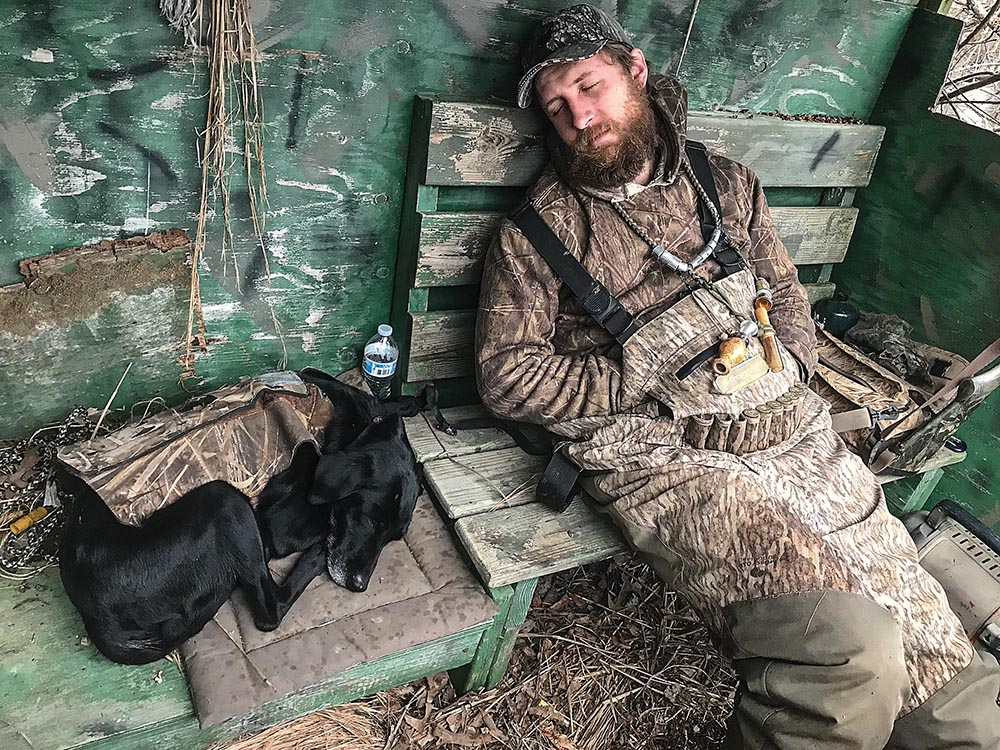James Johnson doesn't hunt.
"My dog hunts. I just shoot," the Chattanooga sportsman says of his German shorthaired pointer, Bolivar Axl Lemondrop Fluffy -- "Bo" for short.
Bo is a bird dog, also known as a gundog, which is specially trained to find, flush or retrieve game birds in the field. It's common for registered hunting dogs like Bo to have long names, a practice that helps separate them from the pack, so to speak.
"When I got him [three years ago], I let each of my granddaughters give him a name," Johnson says. "The 8-year-old chose 'Axl' because she loves rock music; the 6-year-old chose 'Lemondrop' because she loves Harry Potter. The 4-year-old took it the most seriously. She prayed about it for days before choosing 'Fluffy.'"
Johnson chose Bolivar after the Cuban cigar.
Throughout the season, from October to March, Johnson and Bo spend about 35 days in the field, stalking pheasants and quail from the Georgia pines to the Texas prairies. Part of his job as development officer for Pheasants Forever, a nonprofit dedicated to conserving habitats for such birds, is to show these wild places to prospective donors -- often hunters themselves.
For Johnson, the sport is all about honoring nature, both the wildlife and the dog's instinctual ability.
It is fascinating, he says, to watch Bo bound at breakneck speeds, then the instant he picks up a scent, freeze like a statue.
"Sometimes hunters don't even bring a gun. They just want to watch the dog work," he says. "You don't have to train bird dogs to find and point birds. They are born with that ability."
However, bird dogs still require training. First and foremost, they must learn to not immediately pounce on the bird. They also must learn a series of vocal, whistle or hand signals. Bo has been trained in all three, and he understands vocal commands in both English and Spanish. In the field, Johnson says he likes using Spanish commands just to surprise his fellow wingshooters.
Inevitably, "they'll say, 'Wow, your dog speaks Spanish!' And I say, 'Well, I haven't heard him yet.'"
Choosing a hunting companion
Different breeds are good at different things.
When hunting waterfowl, the dog's primary job is to retrieve the kill, making breeds like water-loving Labradors a popular choice. When hunting upland birds such as quail, pheasant, grouse or woodcock, the dog's job is to find and flush the birds, which often take refuge in dense, brambly thickets. For this, pointers or sometimes spaniels are preferred.
"German shorthaired pointers are the trend right now," says Fred Moody, co-owner of The Sawbriar at Big South Fork, a 700-acre hunting preserve stocked with quail and pheasants about two hours north of Chattanooga. Sportsmen who visit the preserve can either bring their own gundogs or hire one of the staff guides, all of whom have their own -- mostly pointers.
The benefit of a pointer, says Moody, is its instinct to point and hold the moment it picks up a scent, giving the hunter time to move closer before the bird flushes. Moody, however, prefers hunting landfowl with a British Labrador – which isn't good at pointing, but is good at flushing, he says.
"You have to be quicker on the trigger," says Moody. But it's a compromise he's willing to make. "I enjoy their temperament. The British Labrador is calm by nature. I can hunt [with] them, but I can also hang out on the back porch with them."
Pointer breeds tend to have more energy, he says.
"It is a fact that German shorthaired pointers have to have two things: lots of affection and lots of activities," says Pheasants Forever's James Johnson, who hunts with a shorthaired pointer -- which he says he also chose for its temperament. "They're not aggressive, and they're extremely loyal."
And the German shorthair, like the Labrador, is a good retriever, too -- a critical skill in duck hunting.
"Have you ever waded around in swampy ice-cold water?" says Moody. "It's remarkable how tough [gundogs] are. Those little boogers can swim out and get that duck before you can even take a sip of hot cocoa."
Follow The Sawbriar at facebook.com/thesawbriar or on Instagram @thesawbriar to learn more about the property.
A bird dog to remember
After 13 seasons of duck hunting together, in January, Jonathan Hall lost his black Labrador, December Noell Cantrell -- "Dee" for short.
"She retrieved 1,093 [ducks] for me in her career," says Hall. "When she passed away, I had a headstone made that included her lifetime total."
It's not necessarily common for hunters to track every bird their dog retrieves, admits Hall. "But I'm sentimental, and I like numbers."
Hall, a raft guide on the Ocoee River, says he chose Dee because of her breed's affinity for water. She quickly adapted to his lifestyle, whether that meant summer naps in the raft barn or winter canoe rides through the predawn swamp.
"I've seen great hunting dogs and great people dogs, but I've never met one that combined the two qualities better than Dee," he says.
One overcast December morning, he and Dee were duck hunting in West Tennessee, where Hall owns a small farm. An hour or so after sunrise, Hall shot a drake as it circled the swamp, causing it to fall from the sky and out of sight.
He knew that finding the bird would be on Dee's nose. He gave the command and after some splashing and sniffing, Dee focused on a small island about 50 yards away. She quickly honed in on one area and began to jump up and down. But Hall was confused. The duck was not there.
Dee was getting older, and Hall wondered if her senses were beginning to fail. He patted her so she knew he wasn't upset and turned to search elsewhere. But Dee wouldn't budge -- instead, she stood on her hind legs and stretched her nose toward the sky. Hall looked up, and 20 feet above his head, his duck was snagged in the branches of a cypress.
He shook its base until the bird dropped to the ground, then let Dee pick it up and hand it to him.
"I received it with thanks," Hall says, "profuse apologies and a resolution to myself that I would never again doubt her abilities."
Long live game birds
The Northern bobwhite is the only quail native to the Southeastern U.S. Once abundant throughout open forests and fields, the bobwhite is now considered "near threatened" by the International Union for Conservation of Nature, with populations declining by 85% since 1966.
Within the past thirty years, "the amount of habitat we've lost for quail and pheasants is equal to the size of Kansas," says James Johnson, development officer for Pheasants Forever, the nation's largest nonprofit organization dedicated to upland habitat conservation.
Since 1982, the organization has spent $900 million on habitat projects benefiting 19 million acres across the country.
"Not only do we work on habitat, but we're the leading organization researching monarch butterflies and honey bees," Johnson says.
In 2013, Pheasants Forever established the Pollinator Habitat Outreach Program, which has since helped protect 966 acres of pollinator habitat across 23 states. A healthy pollinator population supports a healthy landfowl population, says Johnson. Not only do they share similar habitats, but young birds rely on their larvae for food.
Learn more about Pheasants Forever or find a chapter near you at pheasantsforever.org.


